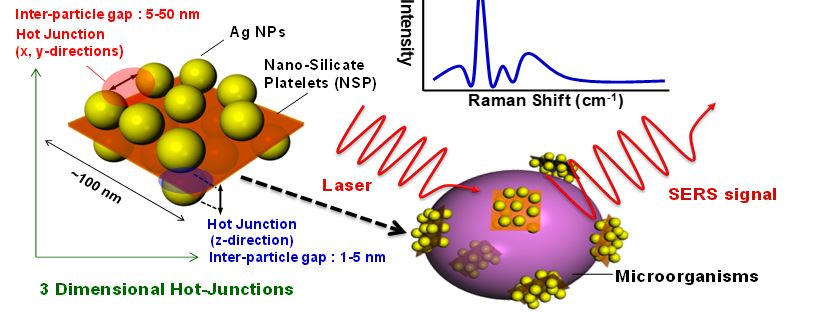Video Article Open Access
Functionalized 2D Nanosheets and Raman Enhancing Nanoparticle Arrays for Biomolecules Detection
Ting-Yu Liu1, 2, 3*, Yu-Wei Cheng4
1Department of Materials Engineering, Ming Chi University of Technology, New Taipei City 243303, Taiwan
2Research Center for Intelligent Medical Devices Center for Plasma and Thin Film Technologies, Ming Chi University of Technology, New Taipei City 243303, Taiwan
3Department of Chemical Engineering and Materials Science, Yuan Ze University, Taoyuan City 32003, Taiwan
4Department of Chemical Engineering, Ming Chi University of Technology, New Taipei City 243303, Taiwan
Vid. Proc. Adv. Mater., Volume 3, Article ID 2210352 (2022)
DOI: 10.5185/vpoam.2022.10352
Publication Date (Web): 17 Oct 2023
Copyright © IAAM
Graphical Abstract

Abstract
Novel nanoparticles arrays of the noble metal nanoparticles (Ag or Au)-on-2D nanosheets materials (graphene or exfoliated clay nanosheets) with flexibility and three-dimensional hot-junctions (particularly in z-direction) were discovered for improving the stability of free nanoparticles and the mobility of rigid (glass or silicon-based) substrates in the surface-enhanced Raman scattering (SERS) detection platform. Since the noble metal Ag nanoparticles (10-30 nm) are adsorbed on both sides of few nanometer-thick nanosheets (single-layer exfoliated nanosheets, with dimensions of 100×100 nm2 and a thickness of 1-5 nm), the geometric arrangement of Ag on both sides of the nanosheets may induce strong (~7 times higher) hot-junctions (z-direction) in reference to the multi-layers at the thickness of 20 nm, measured by small biomolecules (adenine of DNA) and microbes. The resulting nanoparticle arrays nanosheets display a free-floating mobility and optical transparency (less background interference), which inherently increase the contacted surface-area between the substrate and microbes, to enhance the SERS sensitivity. Furthermore, the magnetic (Fe3O4) nanoparticles were immobilized on 2D SERS nanosheets, which displayed the great magnetic capturing behavior and SERS enhancement effect. The bacteria (Escherichia coli) were captured and separated by the magnetic SERS substrates using an applied magnetic field, and then the magnetically captured samples were monitored by Raman spectroscopy for rapid SERS detection. The SERS sensitivity increased by ~2 times after magnetic capturing, and the limit of detection (LOD) for sensing bacteria was below 103 CFU/ml. The novel magnetic SERS 2D nanosheets provide ultrasensitive, rapid, and reproducible SERS detection for magnetically capturing biomolecules (bacteria, uremic toxins, and parathyroid hormone) and can be applied in environmental, water, and biomedical detection.
Keywords
surface-enhanced Raman scattering (SERS) detection; 2D materials & nanosheets; noble metal nanoparticle arrays; bio-detection; magnetic capturing.
Acknowledgement
The authors gratefully acknowledge the financial support of National Science and Technology Council, Taiwan (MOST 111-2221-E-131-020-MY3, MOST 110-2622-E-131-005, and MOST 110-2222-E-131-006-MY2) and Research Center for Intelligent Medical Devices of Ming Chi University of Technology, Taiwan.
References
- M.-C. Yang, A. Hardiansyah, Y.-W. Cheng*, H.-L. Liao, K.-S. Wang, A. R., C. H., J.-S. Chen, R.-J. Jeng*, T.-Y. Liu*, Spectrochimica Acta Part A: Molecular and Biomolecular Spectroscopy, 2022, 281, 121578.
- R.-S. Juang, W.-T. Chen, Y.-W. Cheng*, Z.-L. Zeng, C.-M. Liu, S.-H. Liu, T.-Y. Liu*, Colloid. Surfaces A, 2022, 648, 129189.
- R.-S. Juang, Y.-W. Cheng*, W.-T. Chen, K.-S. Wang, C.-C. Fu, S.-H. Liu, R.-J. Jeng, C.-C. Chen, M.-C. Yang*, T.-Y. Liu*, Appl. Surf. Sci., 2020, 521, 146372
- T.-Y. Liu*, J.-Y. Ho, J.-C. Wei, W.-C. Cheng, I-H. Chen, J. Shiue, H.-H. Wang, J.-K. Wang, Y.-L. Wang and J.-J. Lin*, J. Mater. Chem. B, 2014, 2, 1136.
- J.-Y. Ho, T.-Y. Liu*, J.-C. Wei, J.-K. Wang, Y.-L. Wang, J.-J. Lin*, ACS Appl. Mater. Interfaces, 2014, 6, 1541-1549
Biography
Ting-Yu Liu received his PhD degree at Department of Materials Science and Engineering, National Chiao Tung University, Taiwan in 2008. He visited in Department of Materials Science and Engineering, University of Pennsylvania, USA for 1-year research. After that, he was the post-doc fellow at Institute of Atomic and Molecular Sciences, Academia Sinica, Taiwan from 2009 to 2011, and project assistant professor in Institute of Polymer Science and Engineering, National Taiwan University from 2011 to 2013. He is currently a professor at Department of Materials Engineering, Ming Chi University of Technology, Taiwan. His research covers nanomaterials, biomaterials, polymer composites, opto-electric (surface-enhanced Raman spectroscopy detection) and electrochemical sensing. He has published more than 98 SCI-indexed journal articles and has gotten h-index of 31 according to the citation report from Google Scholar.
Video Proceedings of Advanced Materials

Upcoming Congress



